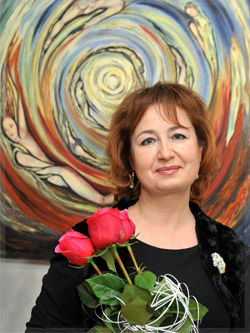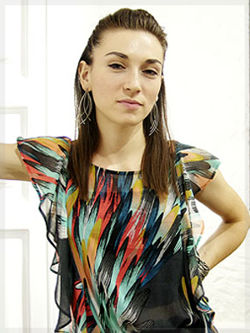


More Than Just a Stain

The «world language of abstraction» is often described as the language of the new start. If art post-1945 did not have a «year zero», since its roots clearly lie in the art of the first half of the 20th century, a new artistic era did begin after the war. Art was redefined. After the war, obviously no-one really believed that the world could be changed with a paintbrush. Barnett Newman recalled that in 1941 he had had the feeling «the world was coming to an end» But at the same time painting lost all its meaning and justification. Impossible to go on painting flowers, figures, people. The question was, what could you do?
The post-war artists put their material to the test: they deprived it of its traditional representational function and allowed it, unadorned and deprived of all its representational functions, to speak for itself. But, unlike the avant-garde after the First World War, the artists after the Second World War did not want to use abstract art to outline new values or utopias for the world. They circled around themselves, in search of individual forms of expression. This produced a confusing diversity of styles and trends. The French abstract painters George Mathieu and Wols had developed a style of uncontrolled writing from the Surrealist ecriture automatique, which they called «Tachisme» («tache», Fr. «stain, mark»). Tachisme was adapted, in an altered form, by German painters like Willi Baumeister, Ernst Wilhelm Nay, Karl Otto Gotz and K.R.H. Sonderborg. In Germany, abstract art was subsumed under the (French) concept of «Informel» - meaning «without form».

There was no longer any compelling canon of what art had to be, and what it had to be like. Only the subjectivity of the artist, which had first become formally defining in Expressionism, was now elevated to the valid standard of artistic production. The extent to which artists paid attention to aesthetic conventions or traditional patterns of composition was entirely up to them. The artistic freedom produced by the abandonment of rules made art more difficult to the wider public. Many people could not understand how this painting, in which everyday life was not present in a single stroke, could be celebrated as an expression of the modern sense of life. Many felt that the paintings were overestimated, dilettante daubs. The most striking characteristic of the paintings was that they no longer represented anything that could be discerned at first glance. They demanded new ways of seeing. What was required was less «reading something out of a painting» that «seeing into it» what imagination, collection, consideration and self-questioning required. To this extent the paintings were entirely in tune with their time. The open lack of any message in the paintings meant that the observer was thrown back on his own devices. He was forced to think about himself and the world.
Jackson Pollock, along with Robert Motherwell and Willem de Kooning the most important representative of American «Abstract Expressionism», gave the people who looked at his paintings the following advice: «They should try to received what the painting has to offer them and not bring to it a main content and a preconceived opinion which they want to have confirmed».

As long ago as 1500, Leonardo da Vinci had praised this kind of imaginative looking in his Treatise of Painting, in which he says: «A new inventive kind of looking consists in this, that you look a wall which is marked with all kinds of stains. If you have to invent a situation, you can see things in it that look like various landscapes. Thorough confused and vague things the spirit wakes to new inventions!» The same is quite certainly true of the paintings of Jackson Pollock. In all other respects, however, Pollock’s works are quite unlike those of the old masters. On the contrary: he brought about the fall of traditional painting in the truest sense of the world. Instead of painting at the easel, he spread his canvases on the floor. When Pollock let the paint drip from thick brushes and pierced tin cans on to the canvas lying on the floor, when he threw and sprayed the paint with wild swings of his arm, and ran across his painting over and over agin like a little dervish, one could not really speak of «painting» in the traditional sense. For this reason, one critic called his work, appropriately enough, «Action Painting». This description makes it plain what Pollock was doing: painting was an action, a real act, however trance-like. The painter could never predict what the final product would look like. Pollock found the titles for his works afterwards - depending on what the structure of his «dripping» reminded him of.But in most cases he just gave them a number or the date on which they were painted. Or he just left them «untitled», to give the observer a completely free hand.

The abstract painters did not want to give instructions, the observer was to create his own individual painting, like a second artist. The painted canvas served as a cause, a model. This creative way of looking so as to bestow a meaning means that the painting is necessarily always current and contemporary, because it only really comes into being at the moment of being looked at and engaged with. For as long as the observer does not supply a possible meaning, the work simply appears as a piece of canvas with paint on it, something that one would be inclined to see more in terms of craft than of art. But precisely because the painting also illustrates a piece of reality, as «evidence», as a document of a working process, it is also realistic in its abstraction. It is a realistic depiction of reality. The traces of paint are traces of the movement of life itself. The painting is no longer a fiction, but the account of an action that really took place. In order to stress how «realistic» their paintings were, most Abstract Expressionists abandoned the heavy frames that usually isolate a work from its surroundings. At the same time Pollock’s all-over painting, his unfocused dripping to the very edge of the painting. But even the Impressionists had used this kind of «framing» to create the impression of being realistic. Jack «the Dripper» now intensified the impression of realistic immediacy with his extremely large formats. The paintings face the observer like a wall. No path, no gaze leads past them. They are part of the environment.

ART.biz introduces today interesting representatives of «Abstract Expressionism» style:
Art Enthusiast from USA - Al Johnson.
Argentine Experimenter - Mariano Kovalsky.
Abstract master from Netherlands - Auke Mulder and his lyrical abstract expressionism.
The Outline Abstraction from Gisela Gaffoglio.
Celeste Nafanoy and her Abstract Dreams on a canvas.
And many other Abstract Expressionists you can find on ART.biz in just a few clicks.
Купить картину



